Phase Equilibria of the Ti-Nb-Mn Ternary System at 1173K, 1273K and 1373K
Abstract
:1. Introduction
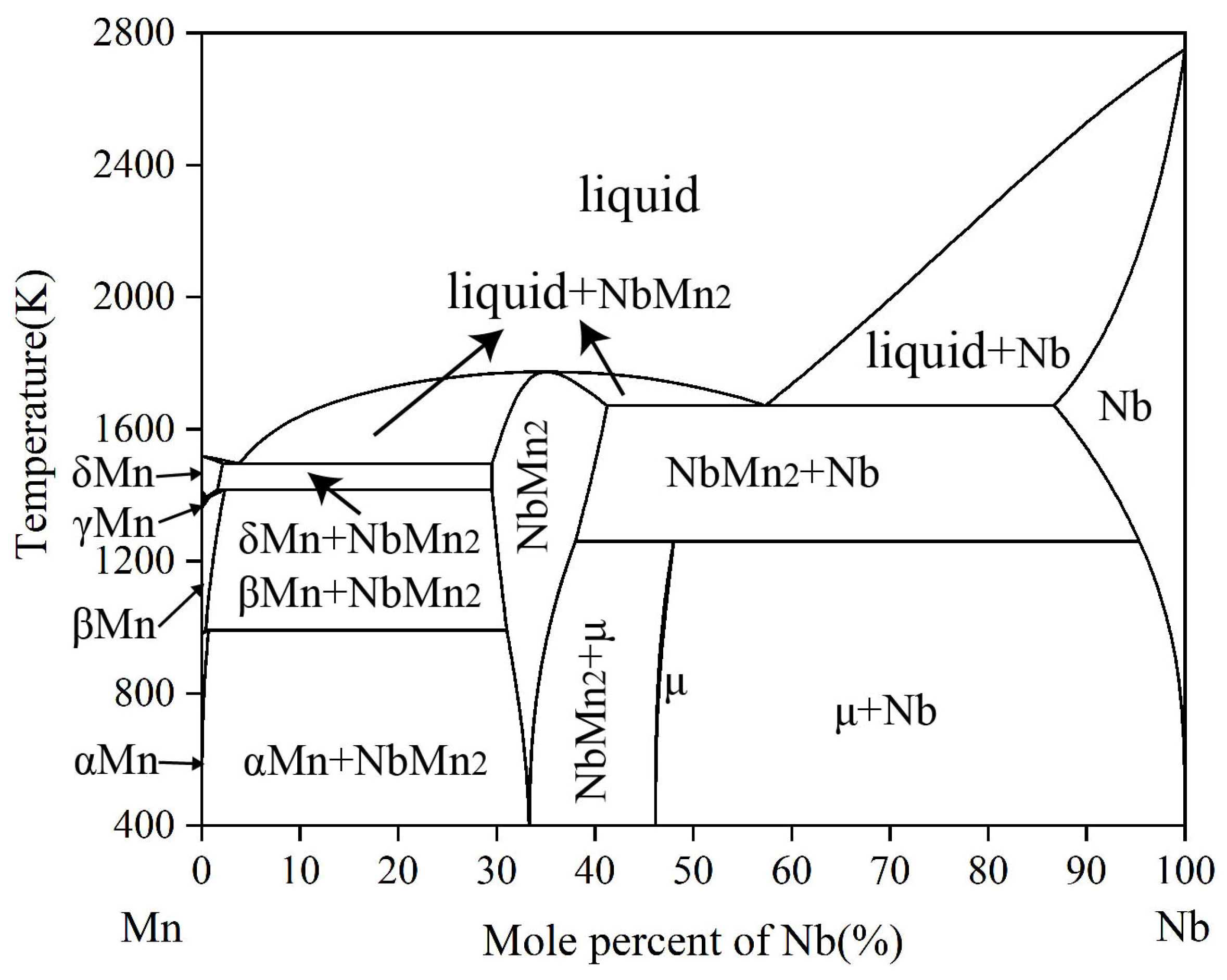
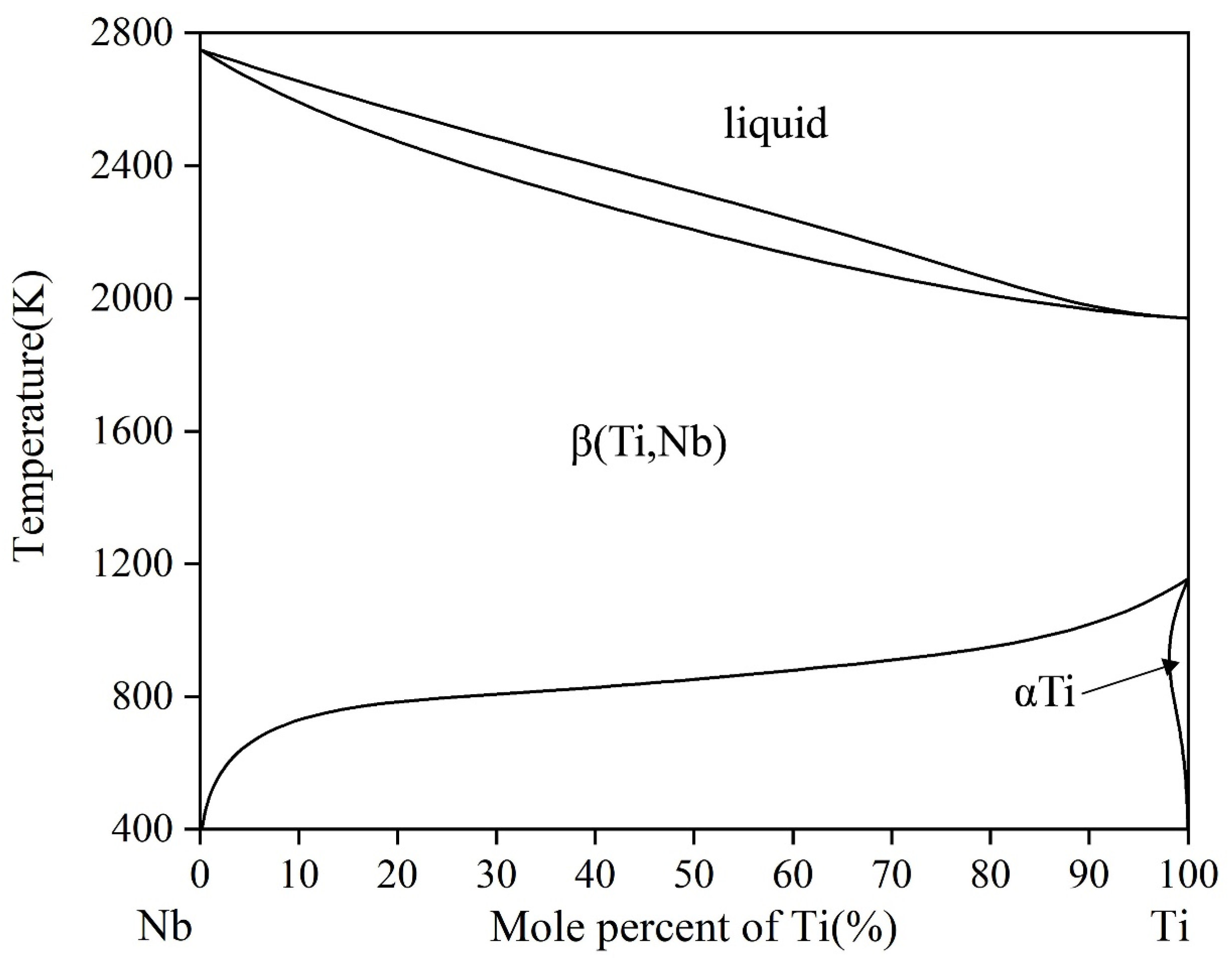
2. Experimental Procedure
3. Experimental Results
4. Discussion
4.1. Phase Equilibria at 1173K
4.2. Phase Equilibria at 1273K
| Alloys No. | Nominal Composition (at %) | Experimental Results (at %) | Phase Determination | ||||
|---|---|---|---|---|---|---|---|
| Ti | Nb | Mn | Ti | Nb | Mn | ||
| B1 | 11 | 47 | 42 | 8.56 | 84.95 | 6.49 | (βTi,Nb) |
| 12.6 | 29.3 | 58.1 | (Ti,Nb)Mn2 | ||||
| B2 | 22 | 38 | 40 | 19.2 | 73.13 | 7.67 | (βTi,Nb) |
| 22.5 | 22.57 | 54.93 | (Ti,Nb)Mn2 | ||||
| B3 | 27 | 27 | 46 | 23.99 | 67.7 | 8.31 | (βTi,Nb) |
| 26.73 | 19.31 | 53.96 | (Ti,Nb)Mn2 | ||||
| B4 | 35 | 27 | 38 | 40.37 | 48.39 | 11.24 | (βTi,Nb) |
| 31.66 | 15.62 | 52.72 | (Ti,Nb)Mn2 | ||||
| B5 | 40 | 15 | 45 | 53.86 | 29.12 | 17.02 | (βTi,Nb) |
| 36.37 | 12.86 | 50.77 | (Ti,Nb)Mn2 | ||||
| B6 | 47 | 12 | 41 | 58.19 | 24.83 | 16.98 | (βTi,Nb) |
| 38.69 | 11.25 | 50.06 | (Ti,Nb)Mn2 | ||||
| 51.96 | 7.4 | 40.64 | K | ||||
| B7 | 54 | 16 | 30 | 58.07 | 24.45 | 17.48 | (βTi,Nb) |
| 37.97 | 11.45 | 50.58 | (Ti,Nb)Mn2 | ||||
| 51.88 | 7.34 | 40.78 | K | ||||
| B8 | 59 | 10 | 31 | 65.8 | 13.78 | 20.42 | (βTi,Nb) |
| 54.84 | 5.9 | 39.26 | K | ||||
| B9 | 56 | 4 | 40 | 69.01 | 4.8 | 26.19 | (βTi,Nb) |
| 53.13 | 4.21 | 42.66 | K | ||||
| 46.89 | 2.22 | 50.89 | βTiMn | ||||
| B10 | 42 | 8 | 50 | 39.24 | 8.24 | 52.52 | (Ti,Nb)Mn2 |
| 52.38 | 6.01 | 41.61 | K | ||||
| B11 | 42 | 6 | 52 | 39.24 | 5.37 | 55.39 | (Ti,Nb)Mn2 |
| 52.37 | 5.42 | 42.21 | K | ||||
| B12 | 14 | 24 | 62 | 51.91 | 5.42 | 42.67 | (Ti,Nb)Mn2 |
| B13 | 20 | 15 | 65 | 20.05 | 14.78 | 65.17 | (Ti,Nb)Mn2 |
| B14 | 27 | 8 | 65 | 26.7 | 8.11 | 65.19 | (Ti,Nb)Mn2 |
| B15 | 34 | 8 | 58 | 35.12 | 8.37 | 56.51 | (Ti,Nb)Mn2 |
| B16 | 23 | 4 | 73 | 24.28 | 4.56 | 71.16 | (Ti,Nb)Mn2 |
| 22.71 | 2.54 | 74.75 | TiMn3 | ||||
| B17 | 20 | 5 | 75 | 19.65 | 8.66 | 71.69 | (Ti,Nb)Mn2 |
| 21.38 | 3.74 | 74.88 | TiMn3 | ||||
| B18 | 22 | 2 | 76 | 22.45 | 1.65 | 75.9 | TiMn3 |
| B19 | 20 | 1 | 79 | 21.73 | 1.12 | 77.15 | TiMn3 |
| 18.33 | 0.95 | 80.72 | TiMn4 | ||||
| B20 | 15 | 2 | 83 | 17.63 | 1.24 | 81.13 | TiMn4 |
| B21 | 12 | 1 | 87 | 11.73 | 0.32 | 87.95 | αMn |
| 14.44 | 0.51 | 85.05 | TiMn4 | ||||
| B22 | 10 | 10 | 80 | 8.01 | 2.45 | 89.54 | αMn |
| 12.58 | 15.62 | 71.8 | (Ti,Nb)Mn2 | ||||
| B23 | 5 | 7 | 88 | 4.29 | 3.98 | 91.73 | αMn |
| 7.42 | 20.46 | 72.12 | (Ti,Nb)Mn2 | ||||
| B24 | 1 | 12 | 87 | 0.24 | 1.79 | 97.97 | βMn |
| 1.27 | 25.67 | 73.06 | (Ti,Nb)Mn2 | ||||
| B25 | 4 | 2 | 94 | 4.23 | 2.93 | 92.84 | αMn |
| 3.94 | 1.56 | 94.5 | βMn | ||||
4.3. Phase Equilibria at 1373K
| Alloys No. | Nominal Composition (at %) | Experimental Results (at %) | Phase Determination | ||||
|---|---|---|---|---|---|---|---|
| Ti | Nb | Mn | Ti | Nb | Mn | ||
| C1 | 6 | 43 | 51 | 5.63 | 86.53 | 7.84 | (βTi,Nb) |
| 6.61 | 33.19 | 60.2 | (Ti,Nb)Mn2 | ||||
| C2 | 20 | 38 | 42 | 24.98 | 63.99 | 11.03 | (βTi,Nb) |
| 18.05 | 25.07 | 56.88 | (Ti,Nb)Mn2 | ||||
| C3 | 27 | 33 | 40 | 32.75 | 54.5 | 12.75 | (βTi,Nb) |
| 23.64 | 21.22 | 55.14 | (Ti,Nb)Mn2 | ||||
| C4 | 36 | 28 | 36 | 42.99 | 41.73 | 15.28 | (βTi,Nb) |
| 30.31 | 17.07 | 52.62 | (Ti,Nb)Mn2 | ||||
| C5 | 40 | 18 | 42 | 47.57 | 9.54 | 42.89 | K |
| 49.84 | 33.02 | 17.14 | (βTi,Nb) | ||||
| 32.98 | 14.07 | 52.95 | (Ti,Nb)Mn2 | ||||
| C6 | 54 | 13 | 33 | 49.78 | 9.19 | 41.03 | K |
| 58.94 | 17.35 | 23.71 | (βTi,Nb) | ||||
| C7 | 53 | 5 | 42 | 46.14 | 2.3 | 51.56 | βTiMn |
| 64.34 | 5.76 | 29.9 | (βTi,Nb) | ||||
| 49.67 | 6.75 | 43.58 | K | ||||
| C8 | 44 | 9 | 47 | 36.22 | 8.1 | 55.68 | (Ti,Nb)Mn2 |
| 47.58 | 7.64 | 44.78 | K | ||||
| C9 | 40 | 8 | 52 | 36.23 | 10.34 | 53.43 | (Ti,Nb)Mn2 |
| 47.35 | 8.8 | 43.85 | K | ||||
| C10 | 13 | 23 | 64 | 13.3 | 23.31 | 63.39 | (Ti,Nb)Mn2 |
| C11 | 22 | 13 | 65 | 21.12 | 13.64 | 65.24 | (Ti,Nb)Mn2 |
| C12 | 30 | 7 | 63 | 28.72 | 6.97 | 64.31 | (Ti,Nb)Mn2 |
5. Conclusions
Author Contributions
Funding
Data Availability Statement
Conflicts of Interest
References
- Baltatu, M.S.; Spataru, M.C.; Verestiuc, L.; Balan, V.; Solcan, C.; Sandu, A.V.; Geanta, V.; Voiculescu, I.; Vizureanu, P. Design, Synthesis, and Preliminary Evaluation for Ti-Mo-Zr-Ta-Si Alloys for Potential Implant Applications. Materials 2019, 14, 6806. [Google Scholar] [CrossRef]
- Rossi, S.; Volgare, L.; Perrin-Pellegrino, C.; Chassigneux, C.; Dousset, E.; Eyraud, M. Dual Electrochemical Treatments to Improve Properties of Ti6Al4V Alloy. Materials 2020, 13, 2479. [Google Scholar] [CrossRef] [PubMed]
- Zhang, L.G.; Tang, J.L.; Wang, Z.Y.; Zhou, J.Y.; Wu, D.; Liu, L.B.; Masset, P.J. Pseudo-spinodal mechanism approach to designing a near-β high-strength titanium alloy through high-throughput technique. Rare Met. 2020, 40, 2099–2108. [Google Scholar] [CrossRef]
- Kim, K.M.; Kim, H.Y.; Miyazaki, S. Effect of Zr Content on Phase Stability, Deformation Behavior, and Young’s Modulus in Ti–Nb–Zr Alloys. Materials 2020, 13, 476. [Google Scholar] [CrossRef] [PubMed] [Green Version]
- Fernandes Santos, P.; Niinomi, M.; Liu, H.; Cho, K.; Nakai, M.; Trenggono, A.; Champagne, S.; Hermawan, H.; Narushima, T. Improvement of microstructure, mechanical and corrosion properties of biomedical Ti-Mn alloys by Mo addition. Mater. Des. 2016, 110, 414–424. [Google Scholar] [CrossRef]
- Arciniegas, M.; Manero, J.M.; Espinar, E.; Llamas, J.M.; Barrera, J.M.; Gil, F.J. New Ni-free superelastic alloy for orthodontic applications. Mater. Sci. Eng. C 2013, 33, 3325–3328. [Google Scholar] [CrossRef]
- Ibrahim, M.K.; Saud, S.N.; Hamzah, E.; Nazim, E.M. Role of Ag addition on microstructure, mechanical properties, corrosion behavior and biocompatibility of porous Ti-30 at% Ta shape memory alloys. J. Cent. South Univ. 2020, 27, 3175–3187. [Google Scholar] [CrossRef]
- Frutos, E.; Karlík, M.; Jiménez, J.A.; Langhansová, H.; Lieskovská, J.; Polcar, T. Development of new β/α″-Ti-Nb-Zr biocompatible coating with low Young’s modulus and high toughness for medical applications. Mater. Des. 2018, 142, 44–55. [Google Scholar] [CrossRef] [Green Version]
- Rachinger, W. A “super-elastic” single crystal calibration bar. Br. J. Appl. Phys. 1958, 9, 250. [Google Scholar] [CrossRef]
- Liu, S.; Liu, J.; Wang, L.; Ma, R.L.; Zhong, Y.; Lu, W.; Zhang, L.C. Superelastic behavior of in-situ eutectic-reaction manufactured high strength 3D porous NiTi-Nb scaffold. Scr. Mater. 2020, 181, 121–126. [Google Scholar] [CrossRef]
- Ramezannejad, A.; Xu, W.; Xiao, W.; Fox, K.; Liang, D.; Qian, M. New insights into nickel-free superelastic titanium alloys for biomedical applications. Curr. Opin. Solid State Mater. Sci. 2019, 23, 100783. [Google Scholar] [CrossRef]
- Alshammari, Y.; Yang, F.; Bolzoni, L. Mechanical properties and microstructure of Ti-Mn alloys produced via powder metallurgy for biomedical applications. J. Mech. Behav. Biomed. Mater. 2019, 91, 391–397. [Google Scholar] [CrossRef] [PubMed]
- Li, C.; Song, Q.; Yang, X.; Wei, Y.; Hu, Q.; Liu, L.; Zhang, L. Experimental Investigation of the Phase Relations in the Fe-Zr-Y Ternary System. Materials 2022, 15, 593. [Google Scholar] [CrossRef] [PubMed]
- Manzo-Garrido, H.; Häberle, P.; Henao, H. Experimental determination of phase equilibrium in Ti-Nb-Mn system at temperatures between 1150 °C and 1200 °C. DYNA 2019, 86, 304–311. [Google Scholar]
- Li, C.H.; Wang, K.; Dong, H.Q.; Lu, X.G.; Ding, W.Z. Thermodynamic modeling of Ti–Cr–Mn ternary system. Calphad 2009, 33, 658–663. [Google Scholar]
- Murray, J.L. The Mn–Ti (Manganese-Titanium) system. Bull. Alloys Phase Diagr. 1981, 2, 334–343. [Google Scholar] [CrossRef]
- Khan, A.U.; Brož, P.; Premović, M.; Pavlů, J.; Vřeštál, J.; Yan, X.; Rogl, P. The Ti–Mn system revisited: Experimental investigation and thermodynamic modelling. Phys. Chem. Chem. Phys. 2016, 18, 23326–23339. [Google Scholar] [CrossRef]
- Liu, S.; Hallstedt, B.; Music, D. Ab initio calculations and thermodynamic modeling for the Fe–Mn–Nb system. Calphad 2012, 38, 43–58. [Google Scholar] [CrossRef]
- Hellawell, A. The constitution of manganese base alloys with metals of the second transition series. J. Less Common Met. 1959, 1, 343–347. [Google Scholar] [CrossRef]
- Savitskii, E.M.; Kopetskii, C.V. Phase Diagram of the Mananese-Titanium and Manganese-Zirconium Systems. Russ. J. Inorg. Chem. 1960, 5, 1173–1179. [Google Scholar]
- Svechnikov, V.; Petkov, V. Formation of Laves Phases in Alloys of Mn with Transition Metals of Groups IVA and VA. Akad. Nauk Ukr. SSR Metallofiz. 1976, 64, 24–28. [Google Scholar]
- Bellen, P.; Kumar, K.H.; Wollants, P. Thermodynamic assessment of the Ni-Ti phase diagram. Int. J. Mater. Res. 1996, 87, 972–978. [Google Scholar] [CrossRef]
- Kaltenbach, K.; Gama, S.; Pinatti, D.G.; Schulze, K.; Henig, E.T. A Contribution to the Ternary System Al-Nb-Ti, Z. Metallkd 1989, 80, 535–539. [Google Scholar]
- Kaufman, L.; Nesor, H. Coupled phase diagrams and thermochemical data for transition metal binary systems—II. Calphad 1978, 21, 81–108. [Google Scholar] [CrossRef]
- Kumar, C.H.; Wollants, P.; Delaey, L. Thermodynamic calculation of Nb-Ti-V phase diagram. Calphad-Comput. Coupling Phase Diagr. Thermochem. 1994, 18, 71–79. [Google Scholar] [CrossRef]
- Zhang, Y.; Liu, H.; Jin, Z. Thermodynamic assessment of the Nb-Ti system. Calphad 2001, 25, 305–317. [Google Scholar] [CrossRef]
- Matsumoto, S.; Tokunaga, T.; Ohtani, H. Thermodynamic analysis of the phase equilibria of the Nb–Ni–Ti system. Mater. Trans. 2005, 46, 2920–2930. [Google Scholar] [CrossRef] [Green Version]
- Okamoto, H. Supplemental Literature Review of Binary Phase Diagrams: Ag-Sn, Al-Pd, Ba-Gd, Ba-Pr, Cu-P, Dy-Ni, Ga-Mn, Gd-Sb, Gd-Zr, Ho-Te, Lu-Sb, and Mn-Nb. J. Phase Equilibria Diffus. 2014, 35, 105–116. [Google Scholar] [CrossRef]
- Liu, J.; Yang, X.; Li, C. Phase relationships in the Ho–Mn–Ti ternary system at 773 K. J. Alloys Compd. 2009, 476, 238–240. [Google Scholar] [CrossRef]
- Okamoto, N.L.; Yuge, K.; Tanaka, K. Atomic displacement in the CrMnFeCoNi high-entropy alloy—A scaling factor to predict solid solution strengthening. AIP Adv. 2016, 6, 125008. [Google Scholar] [CrossRef]

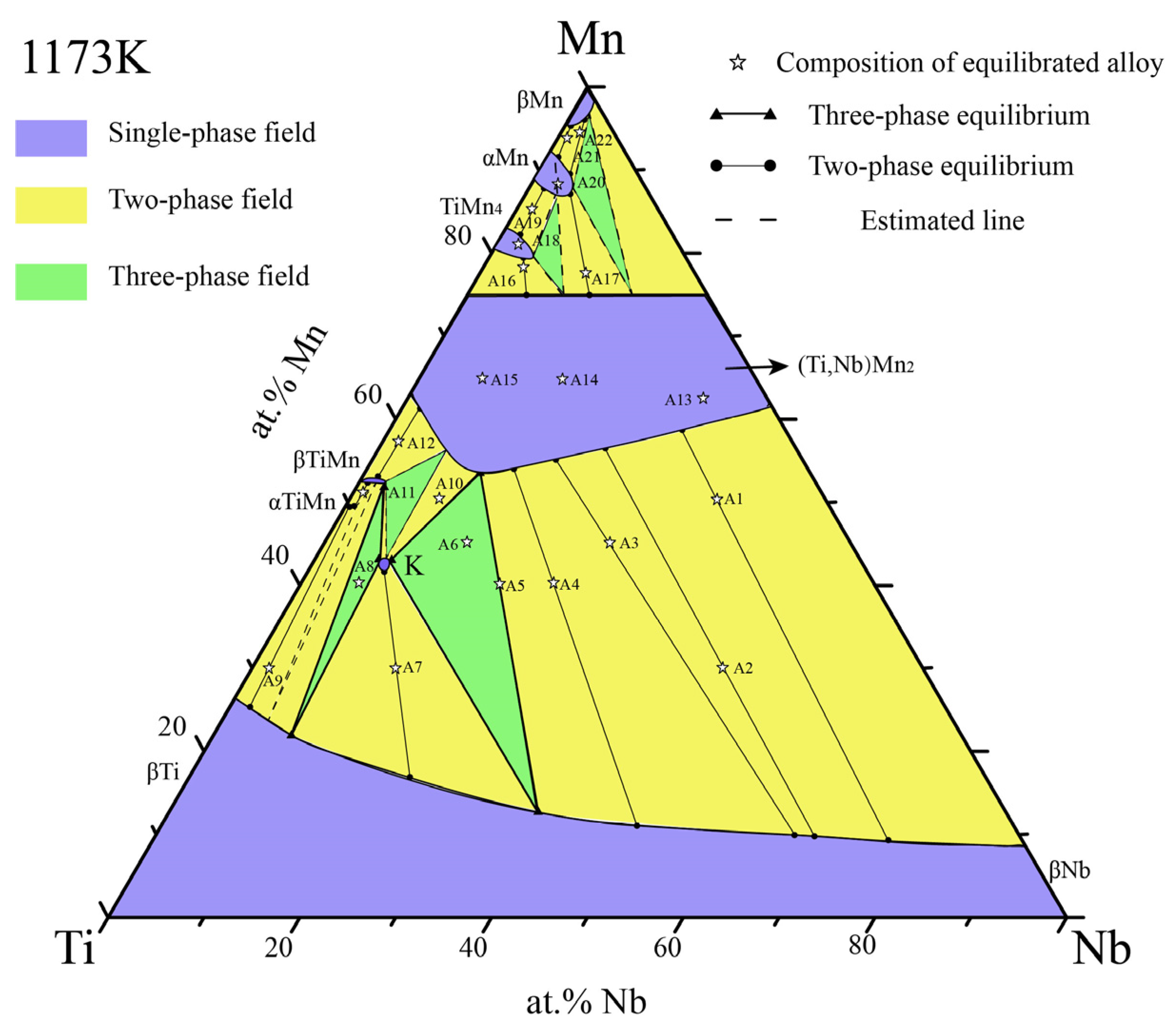
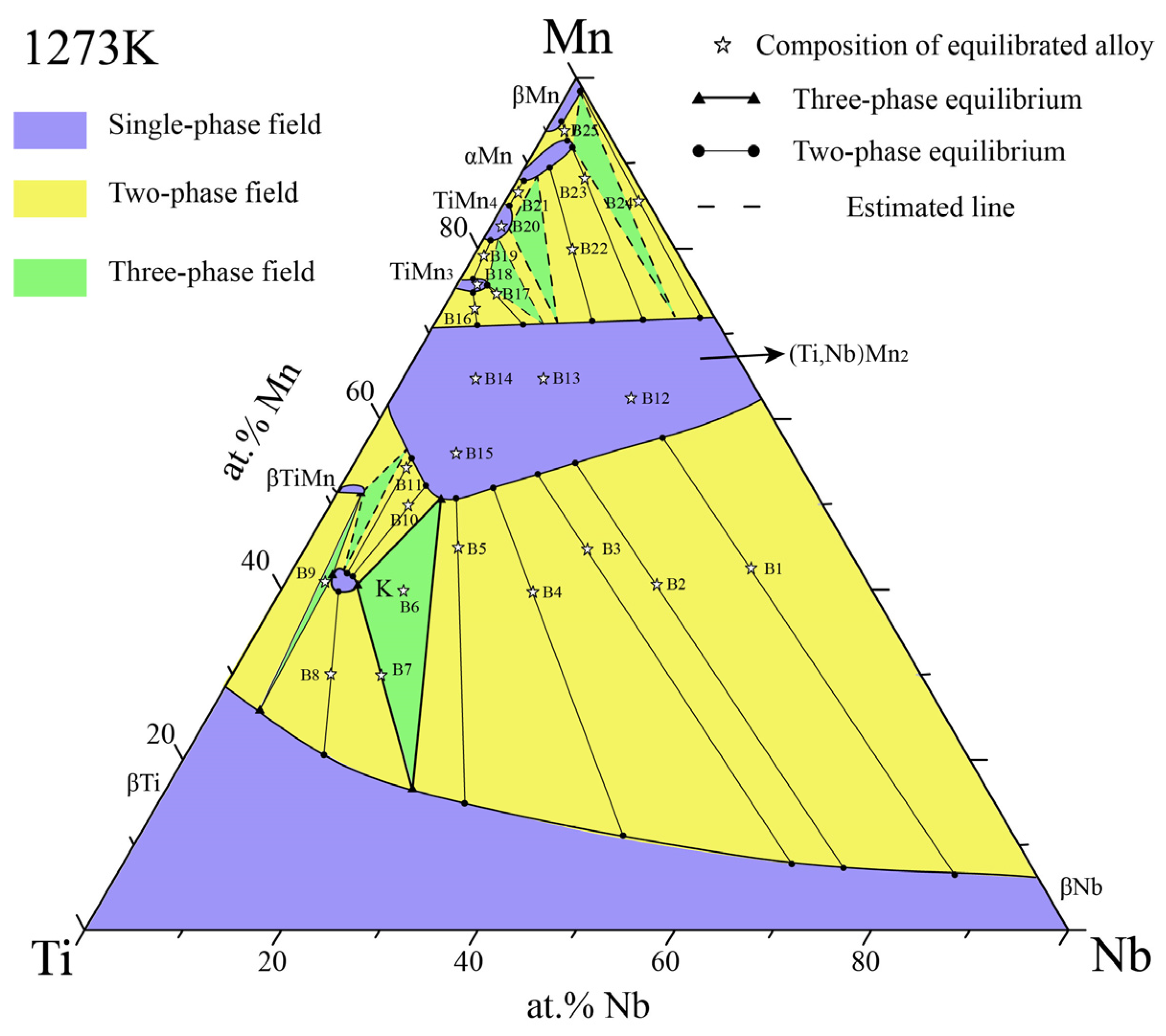
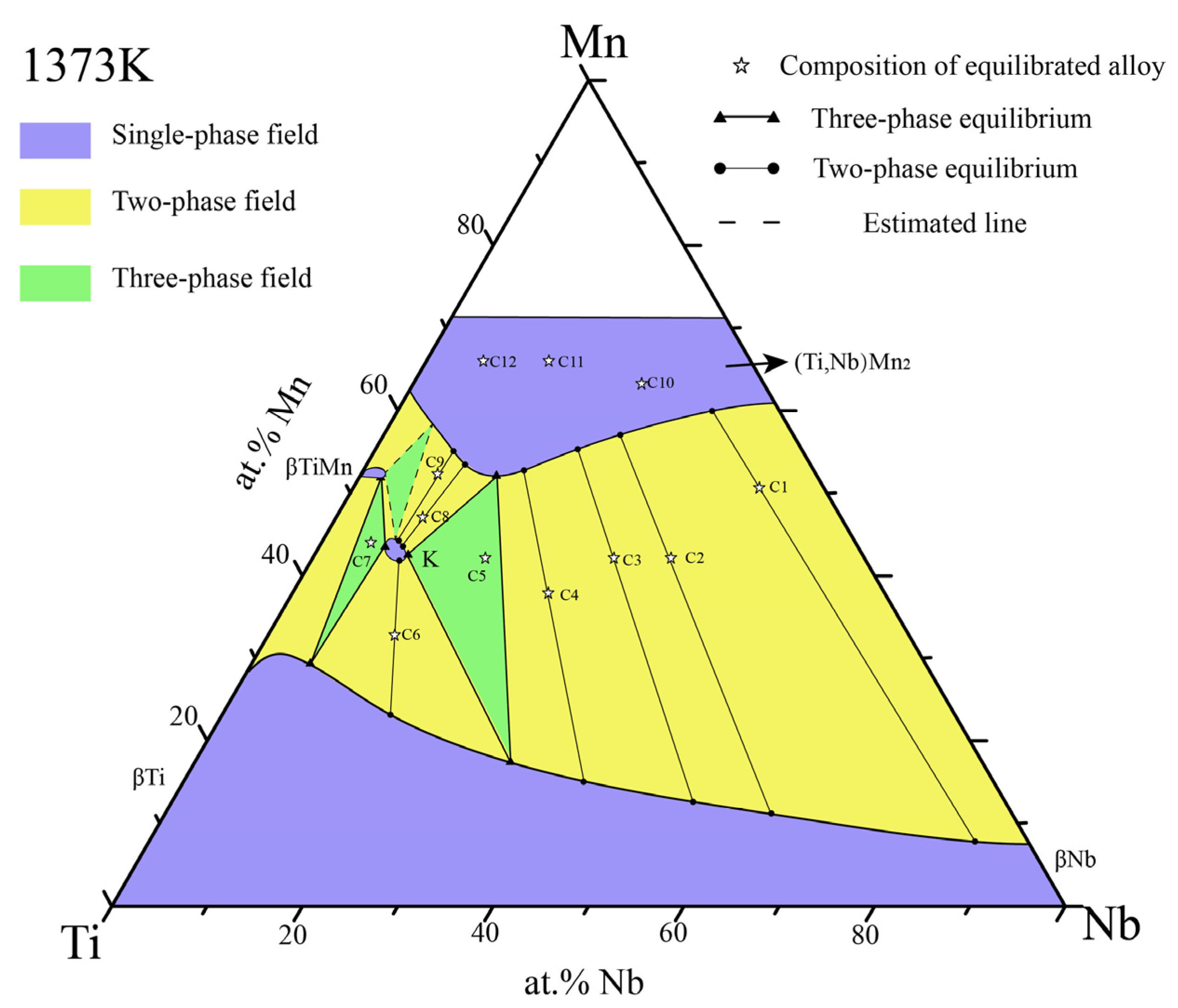
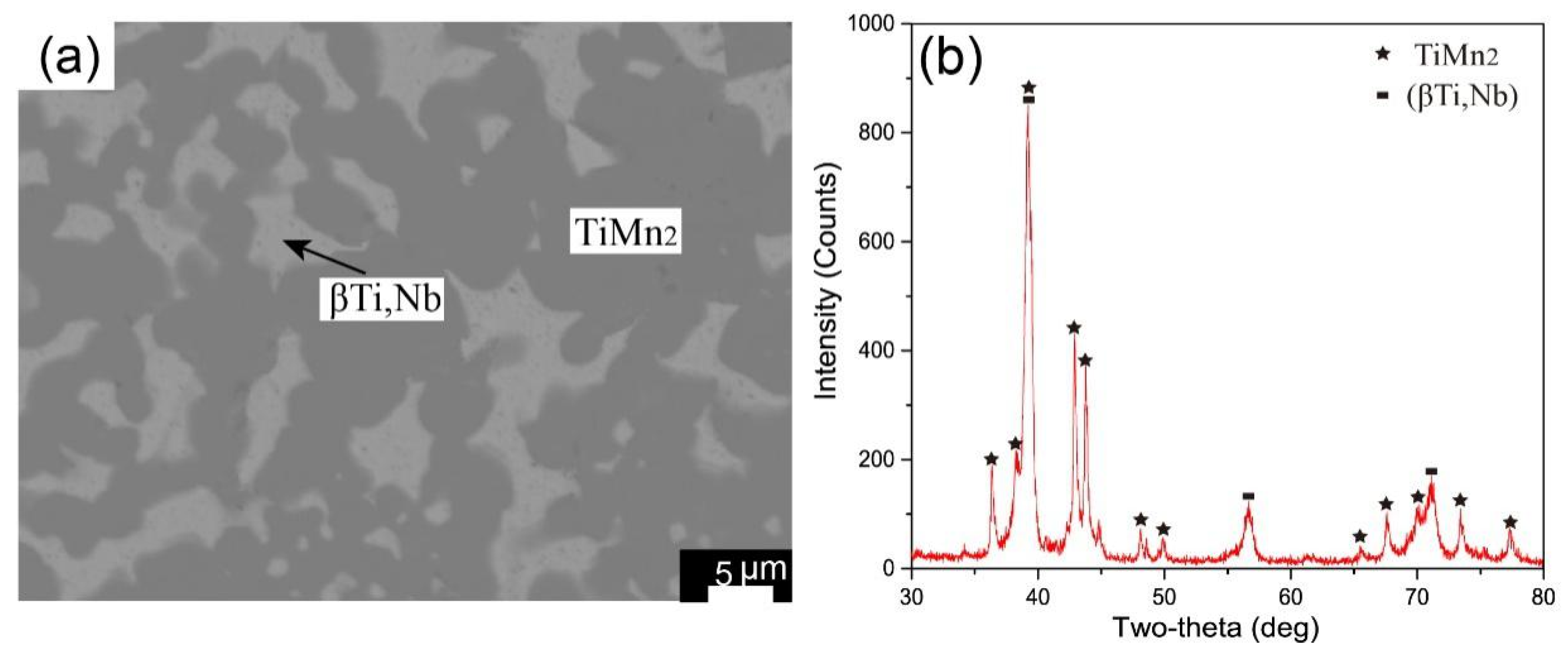
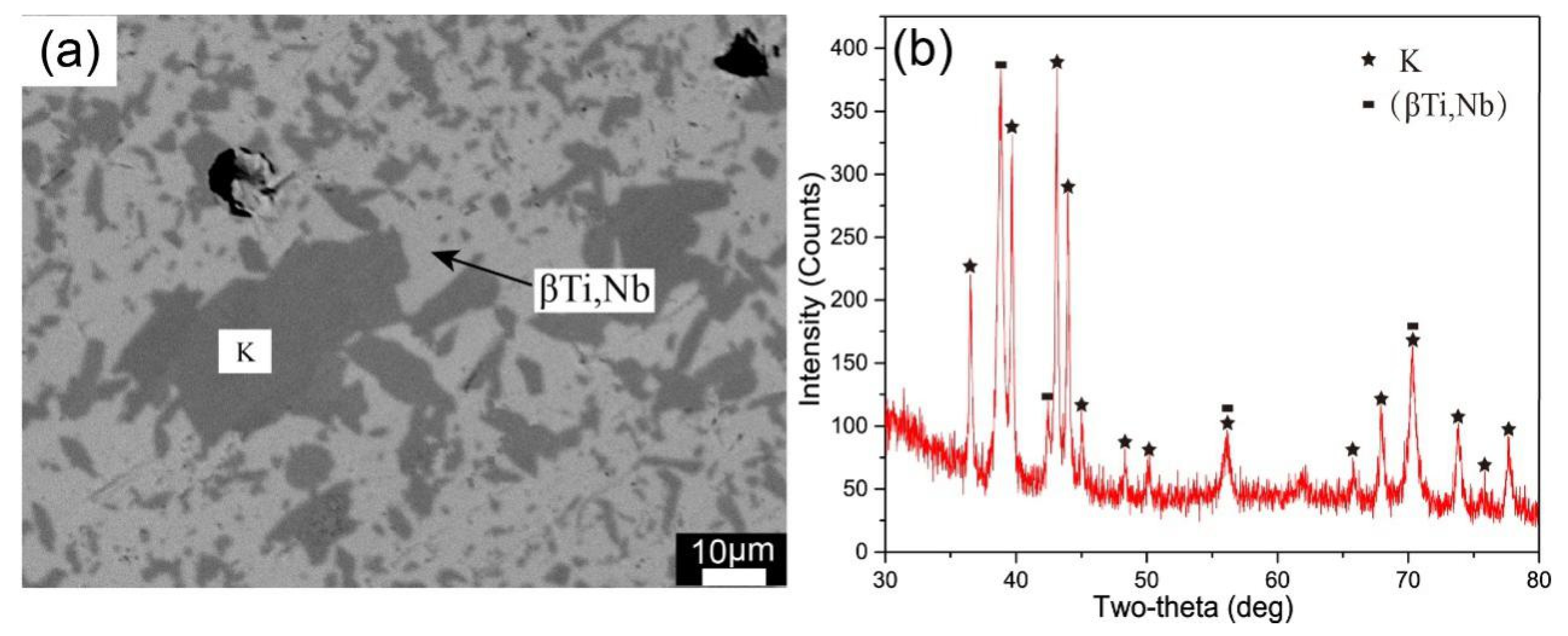

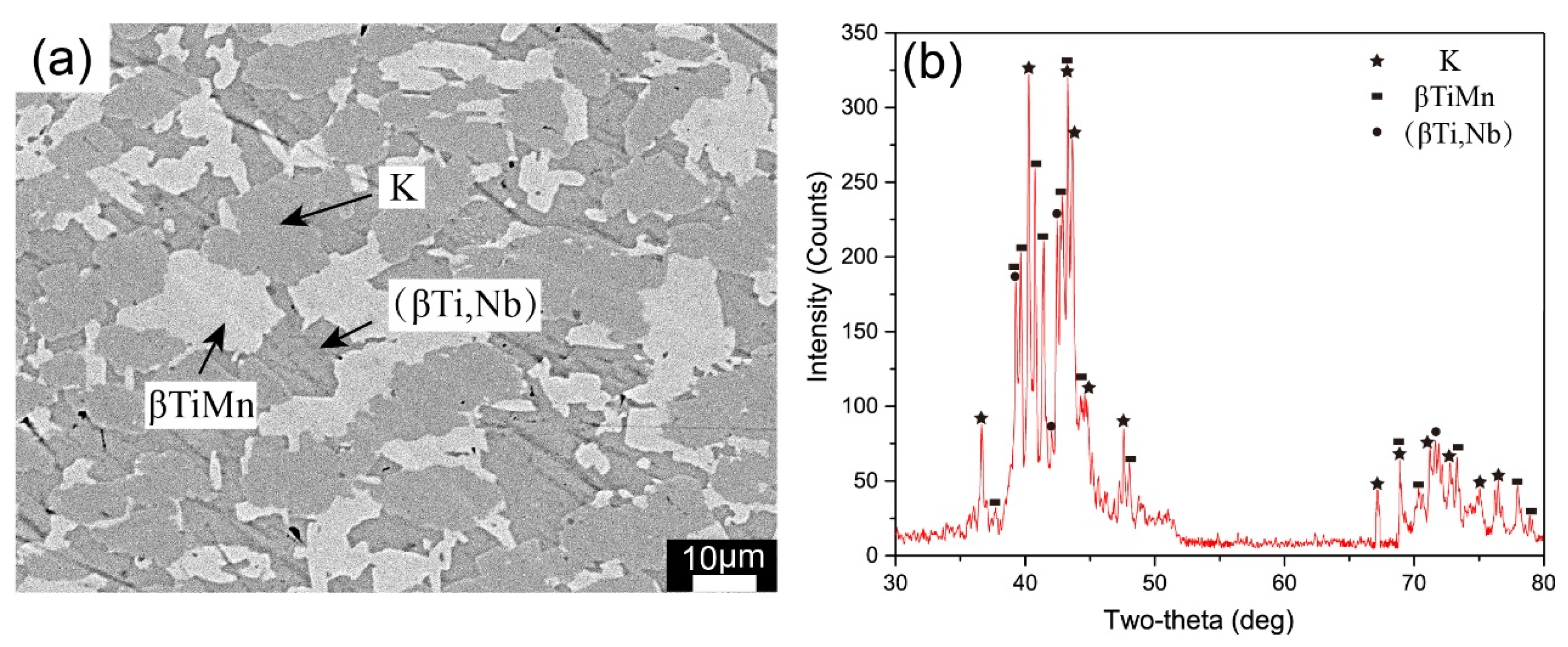
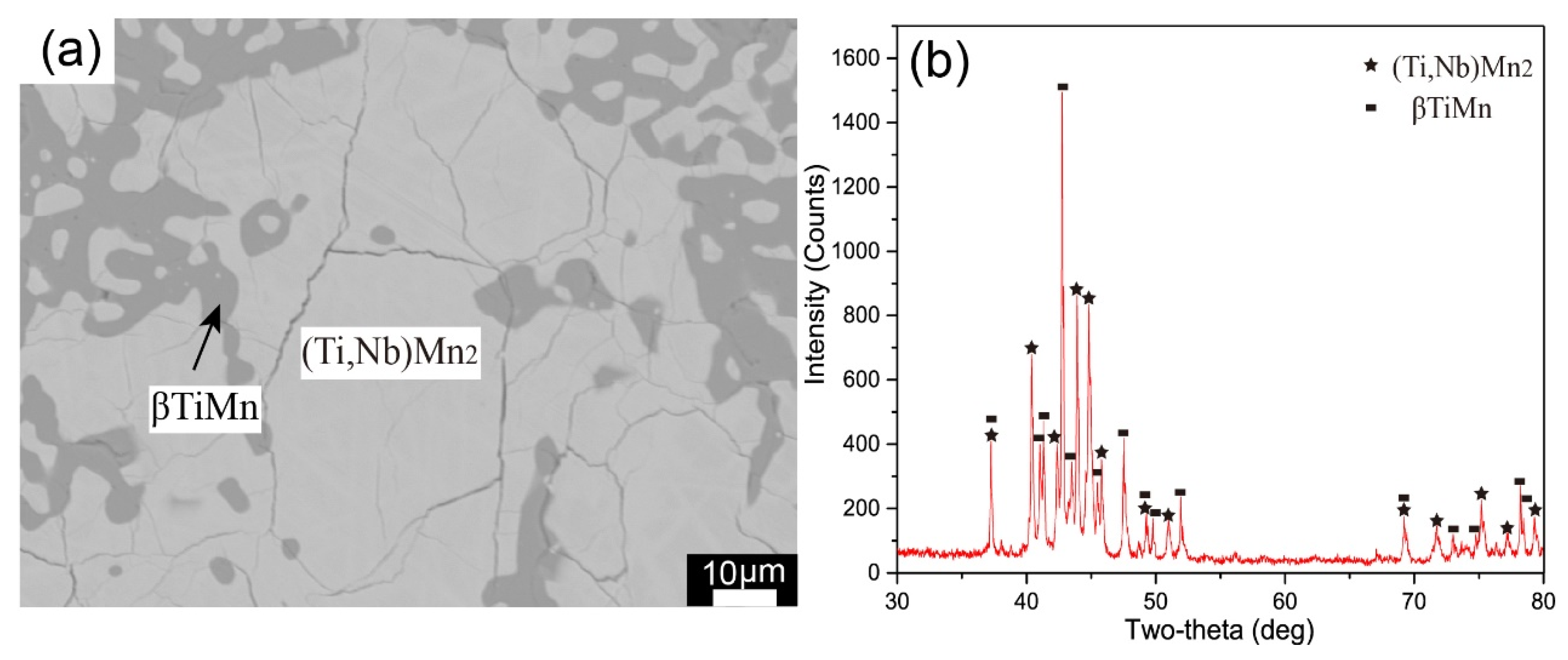

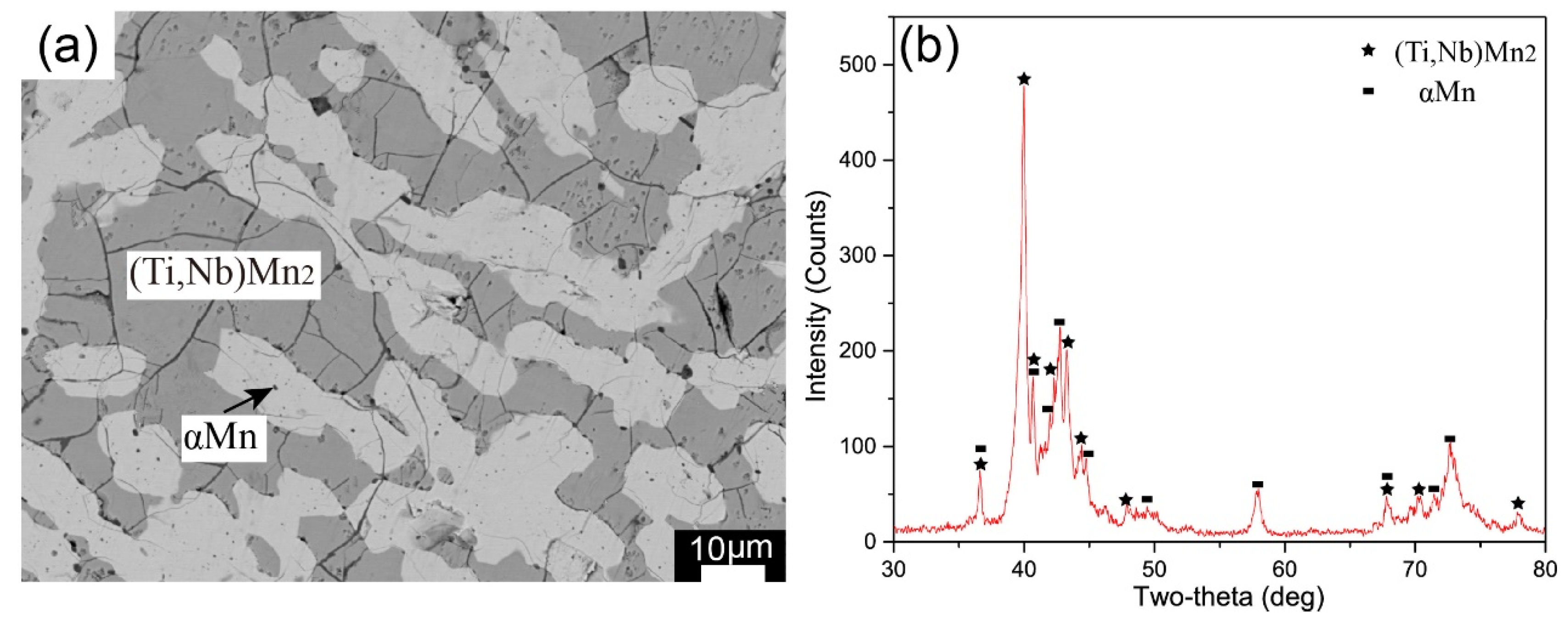
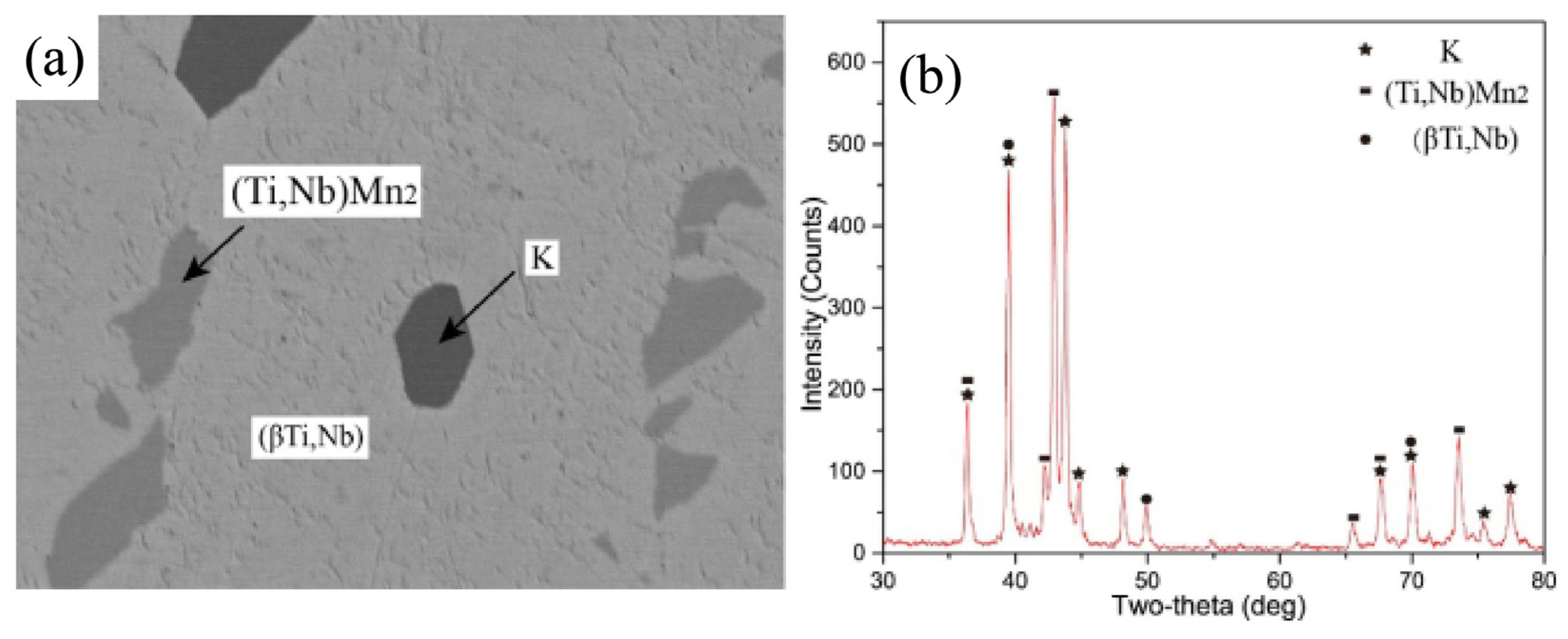

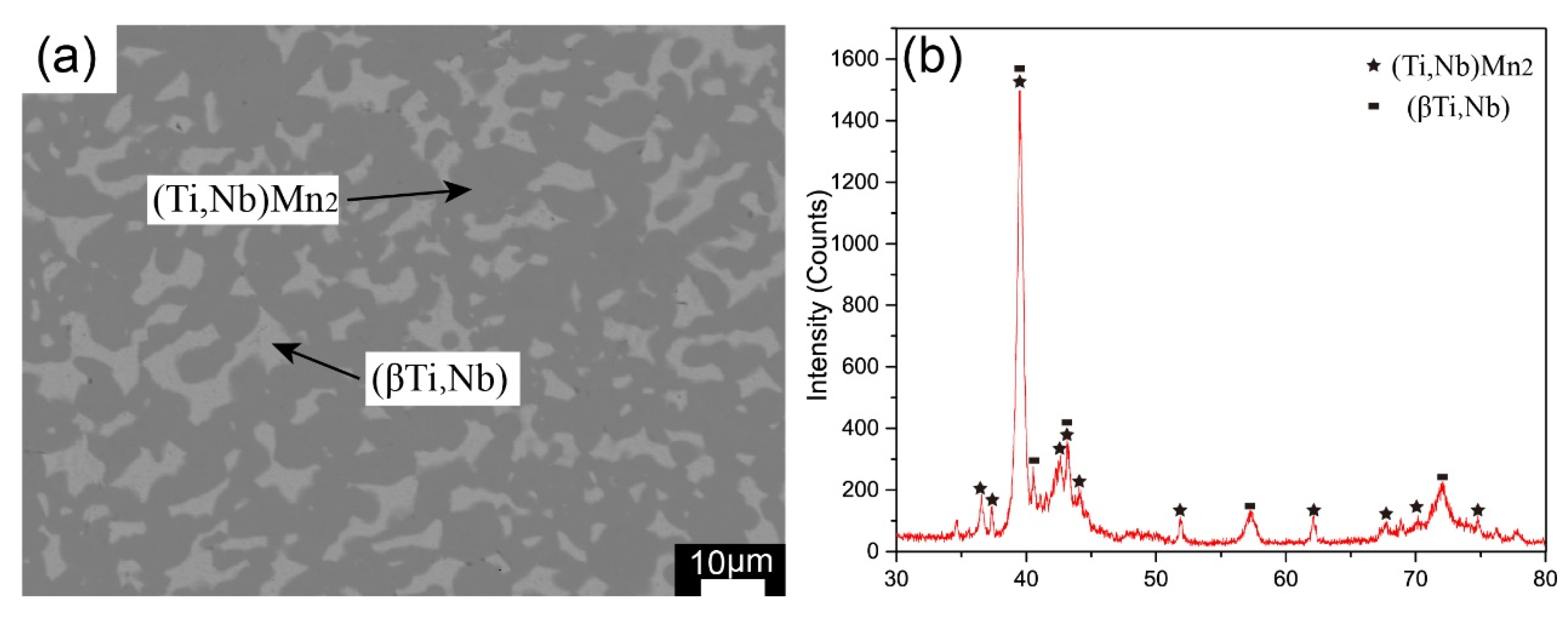
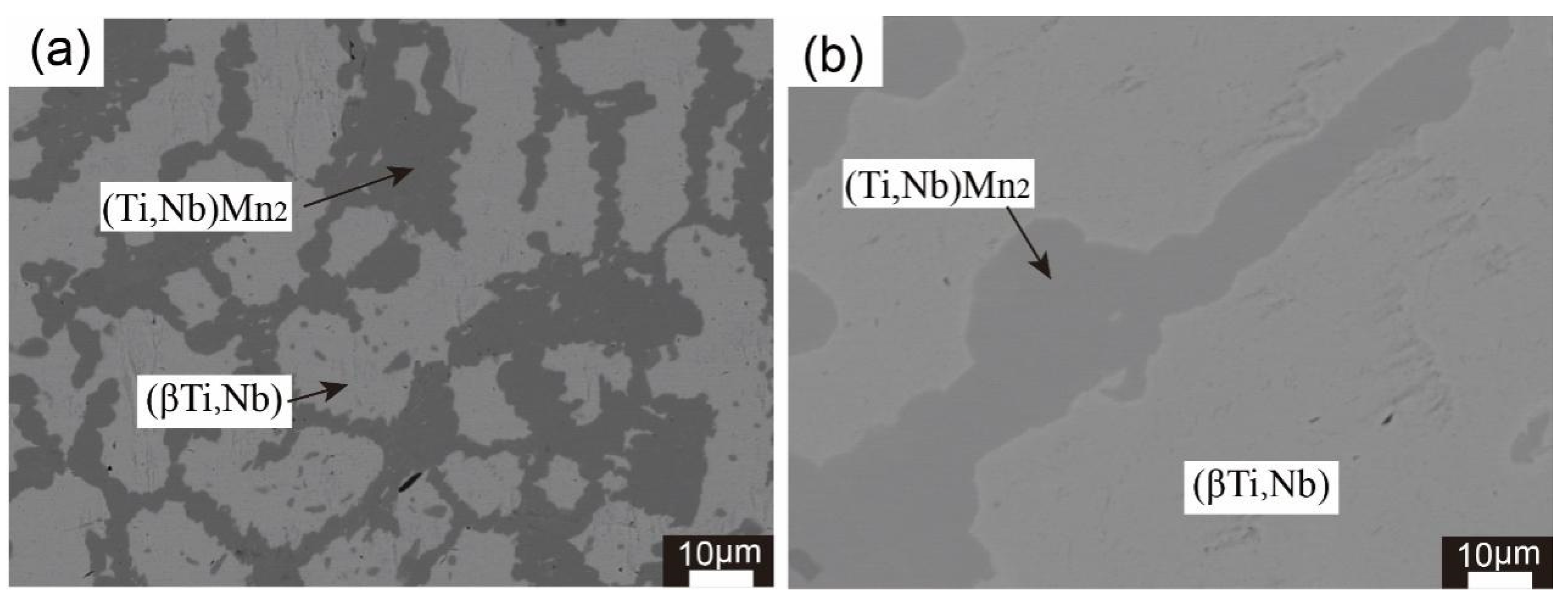





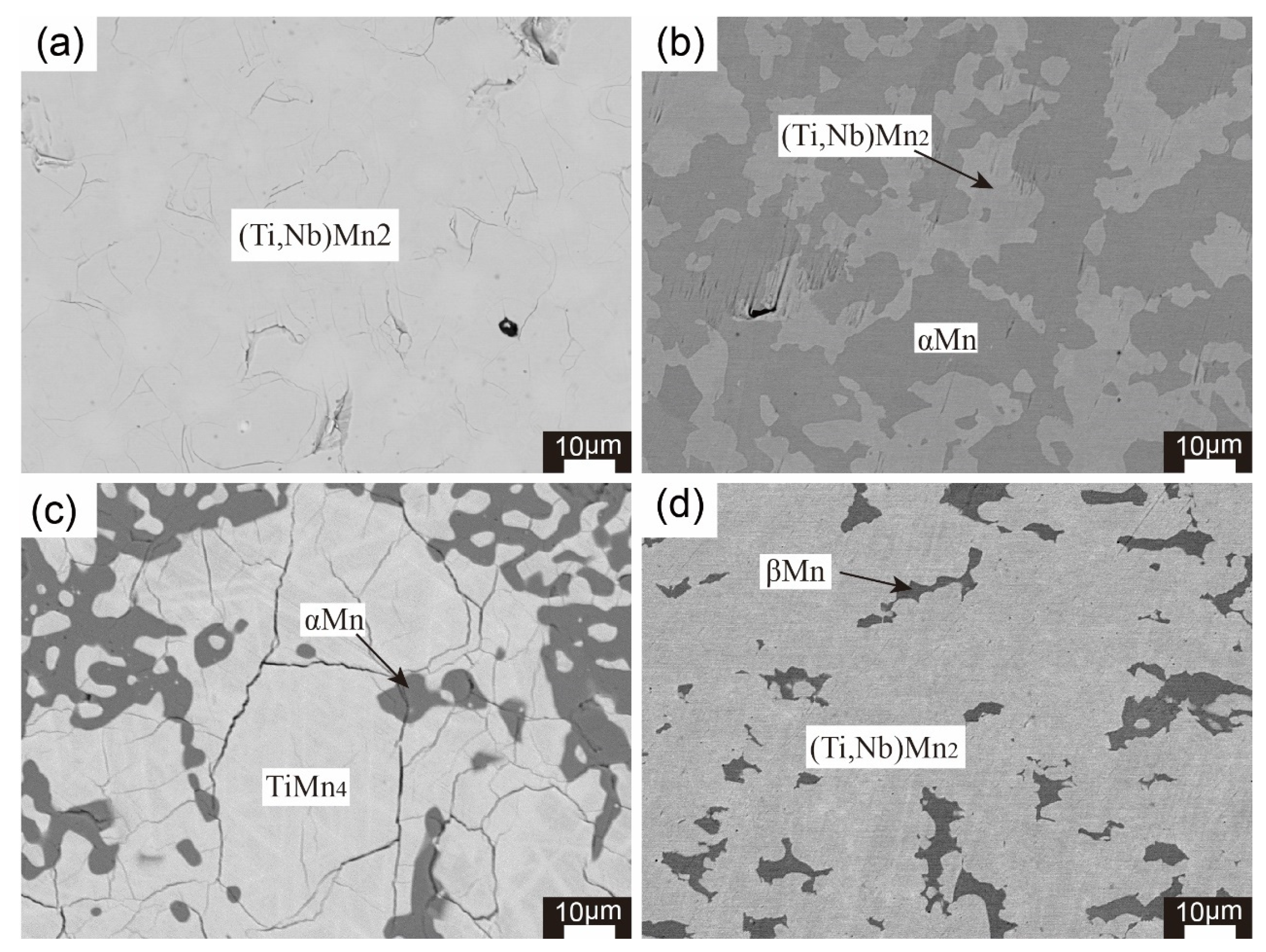
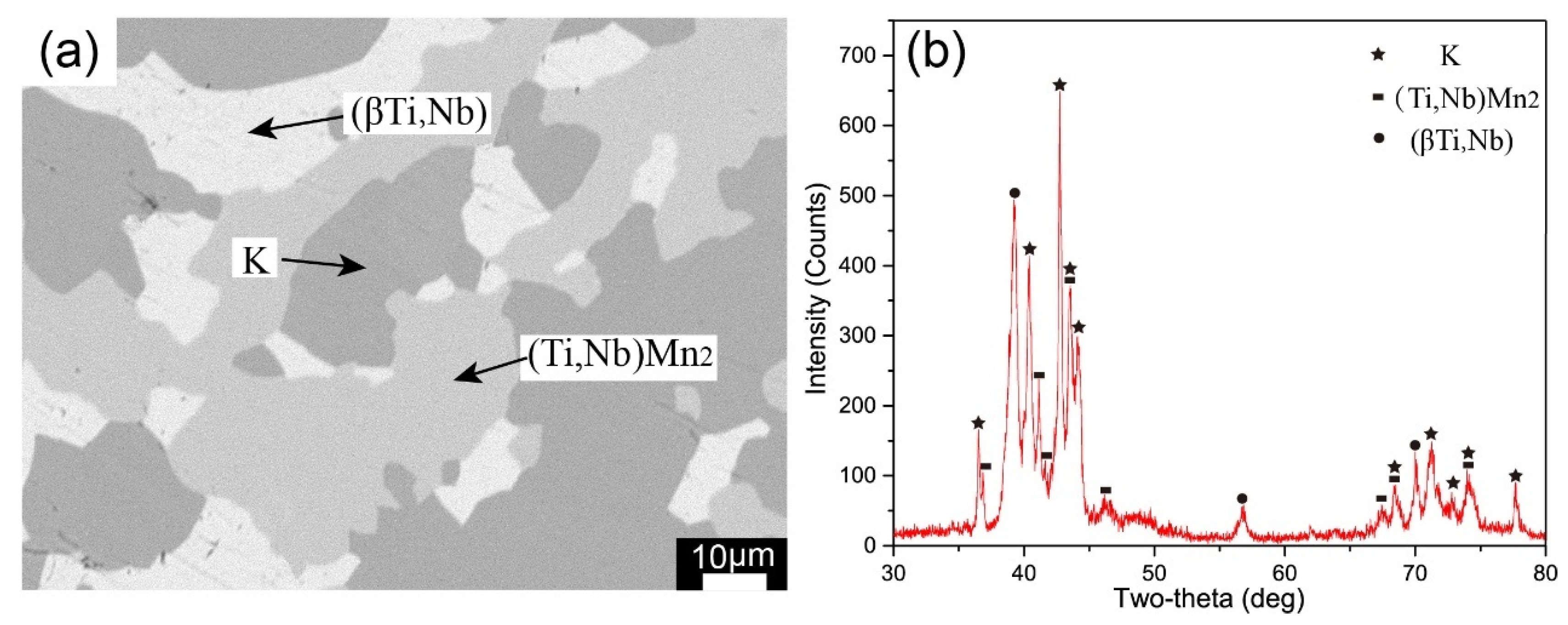


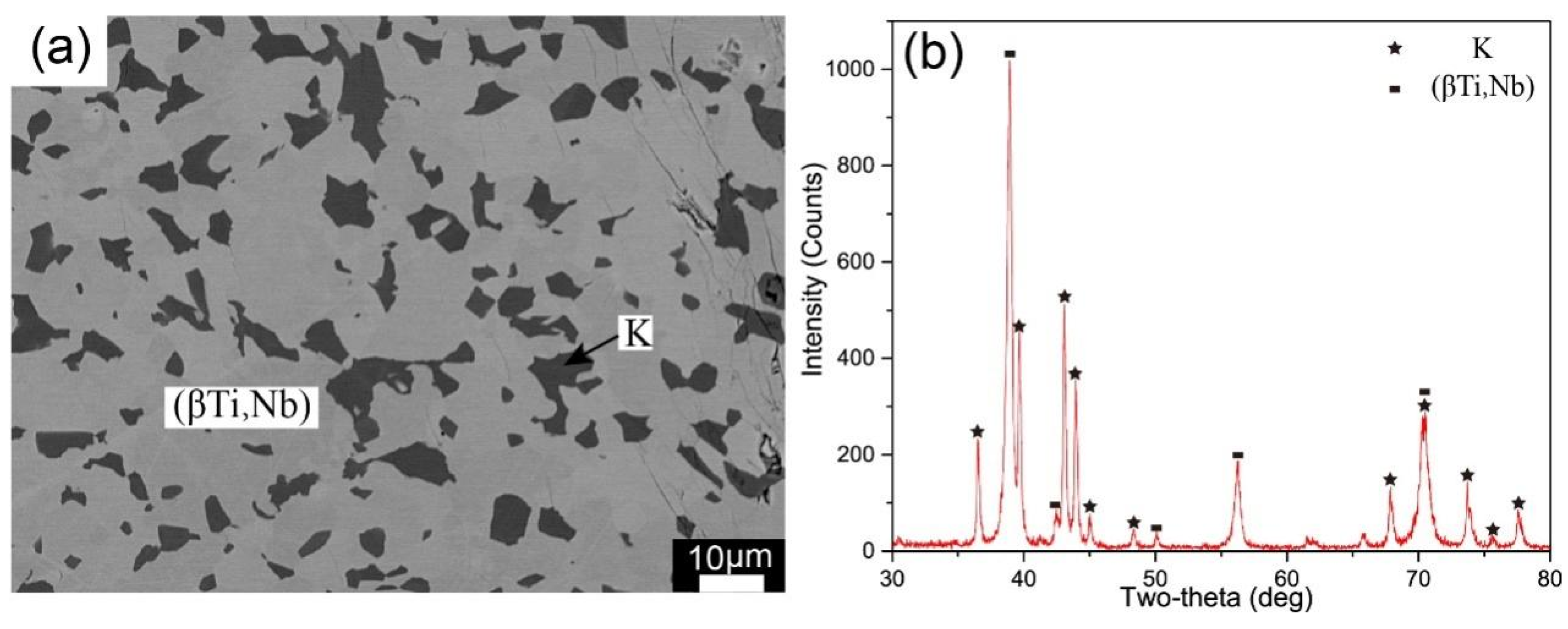
| Phase | Phase Prototype | Space Group | Lattice Parameters (nm) | Reference | ||
|---|---|---|---|---|---|---|
| a | b | c | ||||
| βNb | cI2 | Im-3m | 0.3320 | - | - | [18,28] |
| αTi | hP2 | P63/mmc | 0.2951 | - | 0.4684 | [17] |
| βTi | cI2 | Im-3m | 0.3307 | - | - | [17] |
| αMn | cI58 | I-43m | 0.8913 | - | - | [17] |
| βMn | cP20 | P4312 | 0.6315 | - | - | [17] |
| γMn | cF4 | Fm-3m | 0.3860 | - | - | [17] |
| αTiMn | tP30 | P42/mnm | 0.8731 | - | 0.4390 | [29] |
| βTiMn | - | - | 0.8159 | - | 1.2767 | [29] |
| TiMn2 | hP12 | P63/mmc | 0.47141 | - | 0.78038 | [17] |
| TiMn3 | oP74 | Pbam | 0.79081 | 2.58557 | 0.47931 | [17] |
| TiMn4 | hR53 | R-3 | 0.1007 | - | 0.194411 | [17] |
| NbMn2 | hP12 | P63/mmc | 0.4802 | - | 0.7930 | [18,28] |
| Alloys No. | Nominal Composition (at %) | Experimental Results (at %) | Phase Determination | ||||
|---|---|---|---|---|---|---|---|
| Ti | Nb | Mn | Ti | Nb | Mn | ||
| A1 | 10 | 50 | 40 | 13.91 | 76.62 | 9.47 | (βTi,Nb) |
| 10.75 | 29.81 | 59.44 | (Ti,Nb)Mn2 | ||||
| A2 | 20 | 50 | 30 | 21.78 | 68.53 | 9.69 | (βTi,Nb) |
| 19.9 | 23.21 | 56.89 | (Ti,Nb)Mn2 | ||||
| A3 | 25 | 30 | 45 | 23.61 | 66.7 | 9.69 | (βTi,Nb) |
| 26.44 | 18.38 | 55.18 | (Ti,Nb)Mn2 | ||||
| A4 | 35 | 25 | 40 | 40.37 | 48.39 | 11.24 | (βTi,Nb) |
| 30.66 | 14.91 | 54.43 | (Ti,Nb)Mn2 | ||||
| A5 | 40 | 20 | 40 | 48.18 | 38.97 | 12.85 | (βTi,Nb) |
| 34.77 | 11.91 | 53.32 | (Ti,Nb)Mn2 | ||||
| A6 | 40 | 15 | 45 | 48.68 | 38.57 | 12.75 | (βTi,Nb) |
| 34.27 | 11.91 | 53.82 | (Ti,Nb)Mn2 | ||||
| 49.24 | 7.92 | 42.84 | K | ||||
| A7 | 55 | 15 | 30 | 60.07 | 22.79 | 17.14 | (βTi,Nb) |
| 50.89 | 8.37 | 40.74 | K | ||||
| A8 | 55 | 5 | 40 | 70.13 | 8.04 | 21.83 | (βTi,Nb) |
| 50.88 | 6.89 | 42.23 | K | ||||
| 45.63 | 3.45 | 50.92 | βTiMn | ||||
| A9 | 68 | 2 | 30 | 49.39 | 0.68 | 49.93 | αTiMn |
| 72.53 | 2.26 | 25.21 | (βTi,Nb) | ||||
| A10 | 42 | 9 | 49 | 48.99 | 8.23 | 42.78 | K |
| 36.94 | 9.41 | 53.65 | (Ti,Nb)Mn2 | ||||
| A11 | 47 | 4 | 49 | 45.69 | 3.01 | 51.3 | βTiMn |
| 49.98 | 7.36 | 42.66 | K | ||||
| A12 | 40 | 2 | 58 | 36.67 | 2.18 | 61.15 | (Ti,Nb)Mn2 |
| 44.99 | 1.9 | 53.11 | (βTi,Nb) | ||||
| A13 | 7 | 30 | 63 | 6.79 | 30.27 | 62.94 | (Ti,Nb)Mn2 |
| A14 | 20 | 15 | 65 | 19.91 | 15.11 | 64.98 | (Ti,Nb)Mn2 |
| A15 | 30 | 5 | 65 | 28.42 | 6.93 | 64.65 | (Ti,Nb)Mn2 |
| A16 | 17.5 | 4 | 78.5 | 17.16 | 3.57 | 79.27 | TiMn4 |
| 19.06 | 5.7 | 75.24 | (Ti,Nb)Mn2 | ||||
| A17 | 10 | 10 | 80 | 7.02 | 2.95 | 90.03 | αMn |
| 12.78 | 15.65 | 71.57 | (Ti,Nb)Mn2 | ||||
| A18 | 15 | 2 | 83 | 17.96 | 2.39 | 79.65 | TiMn4 |
| A19 | 14 | 1 | 85 | 14.44 | 1.51 | 84.05 | TiMn4 |
| 10.73 | 1.32 | 87.95 | αMn | ||||
| A20 | 9 | 1 | 90 | 8.91 | 2.06 | 89.03 | αMn |
| A21 | 5 | 1 | 94 | 7.04 | 0.72 | 92.24 | αMn |
| 3.39 | 0.97 | 95.64 | βMn | ||||
| A22 | 3 | 2 | 95 | 6.91 | 2.16 | 90.93 | αMn |
| 2.1 | 2.03 | 95.87 | βMn | ||||
Disclaimer/Publisher’s Note: The statements, opinions and data contained in all publications are solely those of the individual author(s) and contributor(s) and not of MDPI and/or the editor(s). MDPI and/or the editor(s) disclaim responsibility for any injury to people or property resulting from any ideas, methods, instructions or products referred to in the content. |
© 2023 by the authors. Licensee MDPI, Basel, Switzerland. This article is an open access article distributed under the terms and conditions of the Creative Commons Attribution (CC BY) license (https://creativecommons.org/licenses/by/4.0/).
Share and Cite
Li, C.; Guo, H.; Zheng, L.; Yang, J.; Ye, L.; Liu, L.; Zhang, L. Phase Equilibria of the Ti-Nb-Mn Ternary System at 1173K, 1273K and 1373K. Processes 2023, 11, 424. https://doi.org/10.3390/pr11020424
Li C, Guo H, Zheng L, Yang J, Ye L, Liu L, Zhang L. Phase Equilibria of the Ti-Nb-Mn Ternary System at 1173K, 1273K and 1373K. Processes. 2023; 11(2):424. https://doi.org/10.3390/pr11020424
Chicago/Turabian StyleLi, Chenbo, Hongyi Guo, Linghong Zheng, Jifeng Yang, Lideng Ye, Libin Liu, and Ligang Zhang. 2023. "Phase Equilibria of the Ti-Nb-Mn Ternary System at 1173K, 1273K and 1373K" Processes 11, no. 2: 424. https://doi.org/10.3390/pr11020424
APA StyleLi, C., Guo, H., Zheng, L., Yang, J., Ye, L., Liu, L., & Zhang, L. (2023). Phase Equilibria of the Ti-Nb-Mn Ternary System at 1173K, 1273K and 1373K. Processes, 11(2), 424. https://doi.org/10.3390/pr11020424






